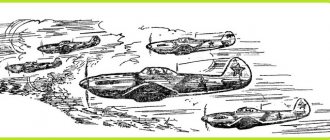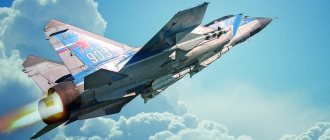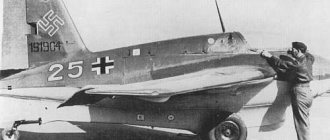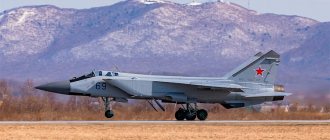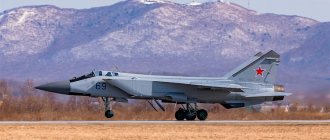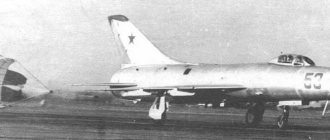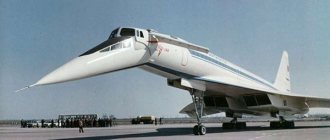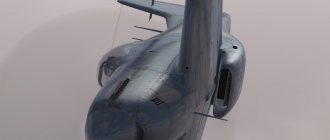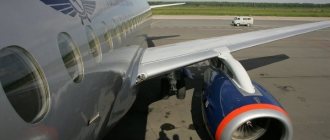Author: Igor
16 January 2022 14:42
Community : Sweatpants & Dumplings
Tags: USSR army aviation
5060
5
To combat reconnaissance balloons, the USSR created a unique aircraft - the M-17 Stratosphere ultra-high-altitude subsonic interceptor.
1.
To combat reconnaissance balloons, the USSR created a unique aircraft - the M-17 Stratosphere ultra-high-altitude subsonic interceptor.
2.
M-17 Stratosphere Dimensions. Engine. Weight. Story. Range of flight
For the first time, the idea of creating a high-altitude aircraft was developed by designer V.M.
Myasishchev matured in the late 1930s, and the development of the high-altitude bomber aircraft DVB-102 began in the “sharaga” - the NKVD prison, officially called the “Central Design Bureau TsKB-29”. At the end of the 1960s. The world was in conditions of military confrontation between two countries - the USA and the USSR. American U-2 high-altitude reconnaissance aircraft constantly flew over our country. On May 1, 1960, one of them was shot down near Sverdlovsk. Having thoroughly studied the remains of what was left of the plane during the fall, they examined the structure and even restored the profile of its wing. V.M. Myasishchev, having gathered a small group of specialists, set them the task: to work out a possible aerodynamic configuration of an aircraft capable of flying in the stratosphere at the lowest subsonic speed. The designer outlined the design of the aircraft being developed: a straight wing with a very high aspect ratio, high weight efficiency, and an engine capable of operating at high altitudes. TsAGI specialists calculated the flight data of the U-2 and obtained a maximum flight altitude of 21 km, but V.M. It seemed to Myasishchev that this was not enough, more was needed. The main thing for such a flight is a good wing profile and an engine, the thrust of which, when flying in the stratosphere, due to a decrease in air density, drops to a value of only 3% of the engine thrust on the ground. The work that began was named “Tema-17” at the OKB, and the future aircraft was named M-17.
The development of the M-17 began with the aerodynamics of the wing, which should have a lift coefficient of about 1.0, which is necessary for cruising flight at high altitude. As a result of theoretical and experimental studies carried out jointly by specialists from the Design Bureau and TsAGI, a profile of a new series was developed. But it soon became clear that at low altitudes the aerodynamic quality of the profile decreased, which led to high fuel consumption and a significant narrowing of flight modes. M-17 contracted the same disease that U-2 chronically suffered from. Experts nevertheless found a way out; retractable mechanization of the trailing edge of the wing was proposed. This made it possible to reduce its area and concavity depending on the flight mode. As the aircraft climbs to altitude, the pilot extends the sectional mechanization, increases the wing area, changes the concavity, and carries out the flight at maximum quality - along the so-called “enveloping polar”. This solution made it possible to fly at altitudes from 0 to 25 km. The created design was protected by a copyright certificate on May 21, 1971.
The power plant of the M-17 aircraft consists of one RD-36-51V jet engine from the Rybinsk Design Bureau designed by P.V. Kolesova. The installation of one engine determined the layout of the future aircraft; in the case of a normal layout, a pipe would have to be dragged through the entire fuselage to organize the nozzle (as on the U-2). In the final version, it was a two-beam design with a high-aspect straight wing of high aspect ratio, having a supercritical profile, and a short fuselage.
The work was carried out in Kumertau (Bashkiria) at a helicopter plant and proceeded rather slowly, since it was new for the plant and was carried out with errors and alterations. The progress of the work was also affected by the sudden death of V.M. Myasishchev in October 1978. Ya. Sokolov became the new leader on the topic. The first prototype crashed during testing. But the work continued, two more copies were built, one for static tests, the other for flight. Tests of the aircraft showed its great capabilities. In 1990, pilots of the EMZ named after. V.M. Myasishchev set 25 world records for height, speed and load capacity for vehicles weighing 16-20 tons. The highest horizontal flight altitude was achieved - 21,800 m. In connection with the conversion, the range of aircraft tasks expanded, one of them was studying the ozone layer over Moscow within the framework of the Global Ozone Reserve project.
Equipment Boeing C-17 Globemaster
The instrumentation includes two HUDs, four multifunctional color indicators, and it is possible to use night vision goggles.
The equipment is represented by an on-board autonomous neutral gas generation system OBIGGS, a Bendix AN/APS-133(V) weather radar, and a satellite system navigation receiver.
Performance characteristics of the M-17 Stratosphere
— Chief designer: V.M. Myasishchev, V.K. Novikov - First flight: May 26, 1982 (successful) - Units produced: 3
Crew of M-17 Stratosphere
— 1 pilot
Dimensions of M-17 Stratosphere
— Length: 22.27 m — Wing span: 40.32 m — Height: 4.87 m — Wing area: 137.7 m² — Wing profile: P-173-9 — Chassis base: 5.618 m — Chassis track: 6 .6 m
Weight M-17 Stratosphere
— Curb weight: 13,790 kg — Normal take-off weight: 18,400 kg — Fuel tank capacity: 10,000 l
Engine M-17 Stratosphere
— 1 × RD-36-51V turbojet engine — Thrust: 1 × 58.84 kN (6000 kgf) (nominal) — Takeoff thrust: 1 × 117.7 kN (12000 kgf) — Thrust at an altitude of 21000 m: 1 × 5, 88 kN (600 kgf)
Speed M-17 Stratosphere
— Maximum speed at an altitude of 20,000 m: 743 km/h — Maximum speed at an altitude of 5,000 m: 332 km/h — Cruising speed: 0.7 M — Landing speed: 188 km/h (with a landing weight of 16,300 kg) — Climb time ceiling height: 35 min — Take-off length: 340 m — Run length: 950 m — Aerodynamic quality: ~30 (gliding with the engine turned off)
M-17 Stratosphere lift-off speed
— 175 km/h
Flight range of M-17 Stratosphere
— Practical range: 1,315 km (from an altitude of 20,250 m to 20,620 m) — Flight duration: 2 hours 14 minutes — Patrol time: 48 minutes
Service ceiling M-17 Stratosphere
— 21,550 m
Supersonic flight of Tu-160
The drag of supersonic flight is high due to the creation of supersonic shock waves, or Mach cones. They are generated by the speed and kinetic energy of the aircraft, taking it away from the body and spreading it in waves from the aircraft into the surrounding space. It is possible to reduce the transfer of energy to shock waves by sharpening all parts of the structure that encounter the supersonic flow. This is how airplanes develop a sharp nose, pointed leading edges of thin wings, fins and stabilizers, and sharp edges of air intakes.
Supersonic drag is reduced by canted wings, the planes of which are retracted back during supersonic flight, realizing variable wing geometry. And an even greater bevel of the frontal part of the cabin. And also by cleaning the body from aerodynamic parts. Nothing should interfere with the supersonic air flow smoothly around the body. All weapons are retracted inside the body to reduce air resistance, leaving no pylons or beam holders, making the surface of the aircraft smooth. Large supersonic air intakes are located in pairs at the bottom of the body to collect leaking gas-dynamically compressed air from the bottom of the fuselage. Their vertical front wedge and the beveled edge of the air intakes behind it demonstrate with textbook clarity the principle of operation of a supersonic air intake. This is how a supersonic aerodynamic appearance is formed. We can say that aerodynamics determined him, becoming the main sculptor of the aircraft, the creator of the form.
Tu-160 in flight / Photo: avi-ator.ru
But supersonic poses problems not only of bringing the shape into compliance. Air resistance still increases significantly with all measures taken. And therefore, an equally significant increase in thrust is required to maintain speed. The thrust increment is created by the afterburning mode of the engine. To do this, a large empty pipe with fuel injectors at the beginning is inserted at the rear of the engine, in front of the jet nozzle - the afterburner combustion chamber. It simply burns additional fuel, abundantly sprayed into a hot stream - exhaust gas behind the turbine, mixed with external air that has passed past the engine combustion chambers and retained its oxygen.
This mighty kerosene burner raises the temperature of the gas in front of the nozzle by a thousand degrees. The jet nozzle, a heat engine for accelerating the gas jet, converts the thermal energy added to the gas into an increase in the exhaust velocity and an increase in the reactive force. For the NK-32 engines, four of which are installed on the Tu-160, the thrust increases from a maximum of 14 tons to an afterburner of 25 tons. The increase in thrust is significant, by 11 tons, almost doubling. This addition of thrust compensates for the increased supersonic drag, maintaining a sufficiently high (with a Mach number of more than two units) supersonic speed.
A powerful increase in afterburner thrust further increases fuel consumption, which increases significantly during afterburner. In NK-32 it quadruples, burning 42 tons per hour. And all four engines at full afterburner consume 168 tons - the entire capacity of the tanks. And although there is a partial afterburner mode, afterburner still requires fuel reserves. A large mass of fuel makes the plane large. So the Tu-160 became the heaviest combat aircraft in history, with a maximum take-off weight of 275 tons. Of which 148 tons are fuel, and this is more than half. The total capacity of the fuel tanks is 171 tons. Why do we need space in the tanks for 23 tons of kerosene in excess of the maximum take-off fueling? Because by in-flight refueling you can refuel them too, in the absence of take-off load on the landing gear. Supersonic capability and afterburner make the Tu-160 a huge combat fuel carrier.
With such dimensions it can be loaded with the appropriate cargo. The standard combat load of the Tu-160 is 22.5 tons, and the maximum is 40 tons. It is clear that at strategic ranges it flies with a standard load, with which its combat radius reaches 7,300 kilometers, part of which it can travel at supersonic speed. All this makes the Tu-160 the largest and most powerful combat aircraft in the world. In intercontinental missiles it would be matched by the 15A18M Satan, the largest and heaviest ballistic missile in the world.
Empowerment
The tactical and technical data obtained from these aircraft is tempting to be subjected to direct comparisons. A shorter range and combat radius means lower combat capabilities of a strategic aircraft and its strike potential; the same approach applies to combat load tonnage. And this is true, if you take only the plane itself, one flying copy. But the aircraft is included in a set of measures to increase its combat capabilities. They can solve problems of a fundamentally greater, unlimited range, radically changing the situation.
For example, by creating a network of air bases around the world, you can provide in-flight refueling from them as many times as needed, increasing the flight range many times over. In such a situation, the pursuit of increasing the autonomous range of the aircraft may lose its meaning. The optimality of fuel reserves carried on board is shifting towards their reduction. Why carry unnecessary things if you can add kerosene everywhere? He will be given a lift in any area of the planet. In January 2022, two B-2s destroyed a militant camp near the city of Sirte in Libya. In this case, takeoff and landing were carried out in one place, at Whiteman Air Force Base in Missouri, with several refuelings during a 34-hour non-stop combat mission. If we speak in terms of combat radius (took off - reached - returned), it was more than ten thousand kilometers.
Refueling B-2 in the air / Photo: theaviationist.com
Similarly, B-2s took off from Whiteman AFB on combat missions in Afghanistan and then returned without landing to their base in Missouri—that is, they flew to the opposite side of the Earth and returned from there without landing. The flight took almost two days, 44 hours, with a range to the target of about 13,000 kilometers. This is the orthodromic range, that is, the range along the orthodrome - the shortest straight line on the surface of the Earth. The range of the route traveled was significantly more than 26,000 kilometers due to reaching refueling points, following designated passages in the territories of other states, avoiding atmospheric fronts and thunderstorms, and other course changes.
With such an organization of strikes, how much is it worth increasing the combat radius of the aircraft and fighting for another two or three thousand kilometers? This will not provide action on the other side of the planet with a return from there. Is the B-2, with actual operation organized in this way, limited to a combat radius of 5,300 kilometers?
- Source: new US strategic bomber will be able to shoot down fighter jets with missiles
According to new information, the US military intends to give the B-21 strategic bomber the ability to carry air-to-air missiles.naked-science.ru
No, exactly the same as the Tu-160. Tu-160 long-range flights are carried out with in-flight refueling. This is how they fly, for example, to Venezuela or along long-distance routes along the coasts of continents. Refueling can increase the supersonic portion of the flight. You can empty the tanks in afterburner, remove the afterburner, slow down, go to subsonic, approach the stratotanker to refuel without almost descending, and then go again in afterburner. Thus, refueling removes the limitation of the aircraft by its nominal range.
Refueling Tu-160 in the air / Photo: avi-ator.ru
A similar situation arises with the weight of the combat load. If the cargo is strategic, then if the carrying capacity is over 20-25 tons, then the difference does not matter much. The catastrophically destructive impact equivalent of megatons would fit into a five or ten ton payload because today's thermonuclear warheads are amazingly compact. The main US strategic thermonuclear bomb B61, weighing 320 kilograms, can produce a power of a third of a megaton. Roughly speaking, a ton of such bombs is a megaton of TNT equivalent. Whether the strategist brings 20 or 30 megatons is not so important. The first megaton released over the targets is important. The second and third are important. But the next megatons will change little, since catastrophic destruction and unacceptable damage will already have been caused. Here, as with range, a constant increase in carrying capacity ceases to be an absolute value. Strategic tasks will be fully accomplished by using only part of the full carrying capacity, leaving an unused part. That is, you can seriously compare carrying capacities beyond practical reasons - but there is no practical sense in this.
Weapons also change the individual combat radius of the strategic aircraft. The main killer tool of the Tu-160 is long-range strategic cruise missiles: the Kh-55SM with a range of 3,000 kilometers and the Kh-101/102 with a range of 5,500 kilometers. Most likely, it is no coincidence that the value of 5500 kilometers is the conventionally accepted limit from which the intercontinental range begins. That is, the Kh-101/102 themselves are missiles with an intercontinental range. Strategic cruise missiles increase the combat radius of an aircraft to its maximum flight range. These are very serious products, with a thermonuclear warhead of 200 kilotons or more.
Strategic cruise missile Kh-55SM in working post-launch position. The wings are open, the tail and engine are extended. / Photo: militaryrussia.ru
Strategic cruise missiles are large, long logs or faceted pillars with narrow folding wings and a retractable turbojet engine. Six to nine meters long, a little less than a meter in diameter, weighing one and a half tons, like the logs of large pyramidal poplars, they are placed in drum launchers inside the cargo compartment in the aircraft body. These launchers operate on the principle of a revolver drum, turning so that the next detachable missile ends up at the bottom of the launcher, above the open doors of the compartment, from where it is ejected downwards. The rocket is not dropped like a bomb, but is ejected in order to quickly exit the aircraft and not create pull currents with its body that could hit it against the aircraft. The Tu-160 has two such installations, six missiles each.
Strategic cruise missiles are subsonic, with a low-altitude flight profile, fit into the terrain, and hide well
These are disposable combat drones; according to the logic of their structure, they are small copies of their carriers. They are also filled with kerosene, which takes up more than half of their weight. They also fly thousands of kilometers on their turbojet engine, continuing the flight of the carrier. And for hours they carry their relatively light warhead, 200-400 kilograms, to the target.
It is wiser to launch missiles at their maximum range, without getting closer to the target than necessary. This allows you to remain outside enemy territory when launching missiles in almost half of the cases. You just need to go to a given point in space with the required course, without looking for a target either in the sky or on the terrain. It will be found by a missile whose control system contains target data.
The total range of action of the missile aviation complex thus reaches 7300 + 5500 = 12,800 kilometers. This is the range of intercontinental ballistic missiles to which a strategist can deliver a charge in a non-ballistic manner, with high air speed and other advantages of aviation. In this regard, it serves as an alternative option to ballistics - and an extremely important option, following its own independent path of implementation.
But, in addition to strategic cruise missiles, it is possible to launch missiles of shorter range and power. With them, the “strategist” is capable of performing tactical tasks, but at a great distance. The same opportunity opens up when using conventional free-fall bombs. Here the tonnage in the bomb bay is already important, but 20 tons is enough to make the strike powerful and destructive.
Aeroballistic missiles can carry out tactical and strategic nuclear strikes. Tactical cruise missiles - solve a wide range of local problems. Free-falling ammunition can cover a train moving across the terrain, moving mobile launchers, and any stationary target.
Eagle vision
The navigation system consists of several segments using different data channels. The inertial navigation unit is complemented by astro- and satellite navigation. Data from all segments is processed to determine current coordinates with high accuracy.
Object detection is another matter. It is necessary for tactical targets that have to be flown to and processed close or on the spot. To do this you need to find them on the ground. It will take the eyes of an eagle and the vigilance of an owl. Then phased array antennas and synthetic aperture radars, sighting and navigation systems, optics, work in the infrared channel and other matters of detection, recognition and target designation come into play. In addition, it is necessary to detect objects that are not necessarily targets, but which must be evaded, such as enemy air defense systems. The third type of detected objects identifies a possible or ongoing attack on the aircraft - incoming fighters and missiles.
The Tu-160 and V-2 were forced to be equipped with complex on-board systems that controlled both the observation of targets and the operation of weapons against them. This also includes electronic warfare systems and various types of jamming. Processing large volumes of data required high automation of onboard processes, which made it possible to reduce the B-2 crew to a minimum of two people. One is asleep, the other pilots in cruising mode - but both work during refueling and during combat use. The Tu-160 crew consists of four people.
These are two different aircraft with the same purpose. Their comparison shows a greater conventionality of comparisons. What conclusions can be drawn from all of the above? Paradoxically, conclusions are not always the most valuable part of the story. They may not exist, they may turn out differently, so we will leave it to the kind readers to make them themselves. The balance of power with these two strategists is continuously supplemented and changed, evolving. New ammunition and application schemes are appearing, and aircraft on-board systems are being modernized. They are in the flow of technical development and are refined throughout their lives. The new Kh-101 strategic cruise missile with a range of 5,500 kilometers significantly increases the overall range of the Tu-160 aircraft. In the thermonuclear version (X-102), it significantly increases the total power delivered by one aircraft.
An example of aircraft modernization is the Tu-160M2. The upgrade affected several important components: firstly, the upgraded NK-32 engines of the second series have become more economical, which will increase the combat radius of the aircraft by a thousand kilometers. Secondly, the on-board equipment will be replenished with a new inertial navigation system, a modernized electronic warfare system, and the capabilities of weapon control systems will increase. Elements of the new equipment used on the Tu-160M2 are further planned to be used in the PAK DA aircraft.
